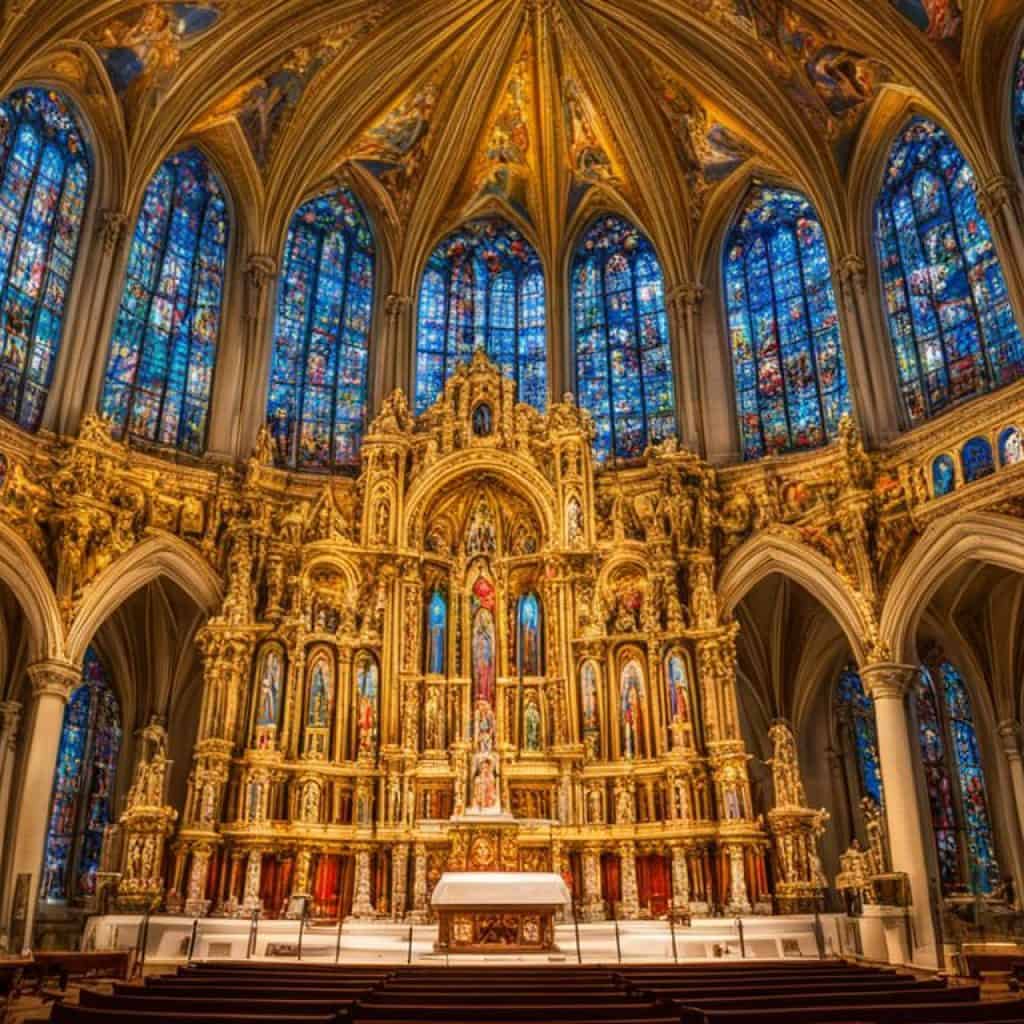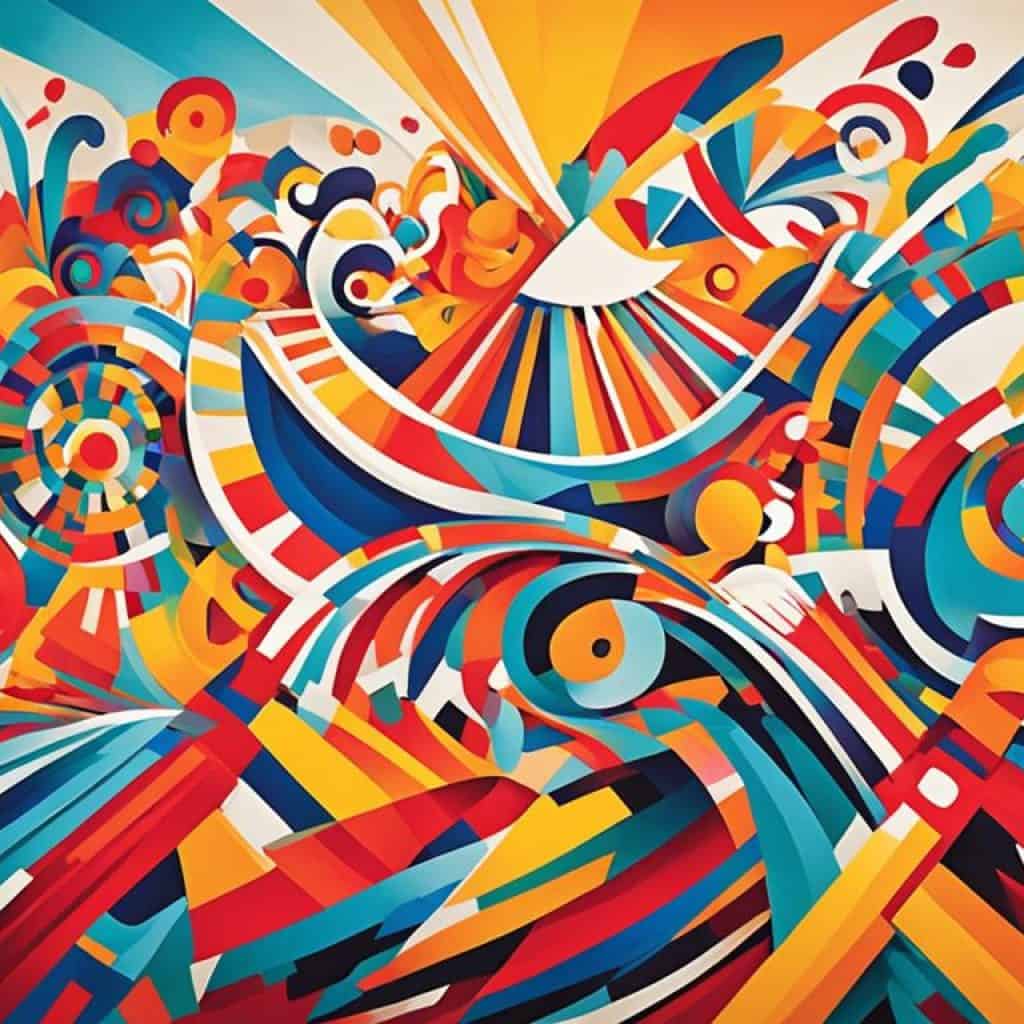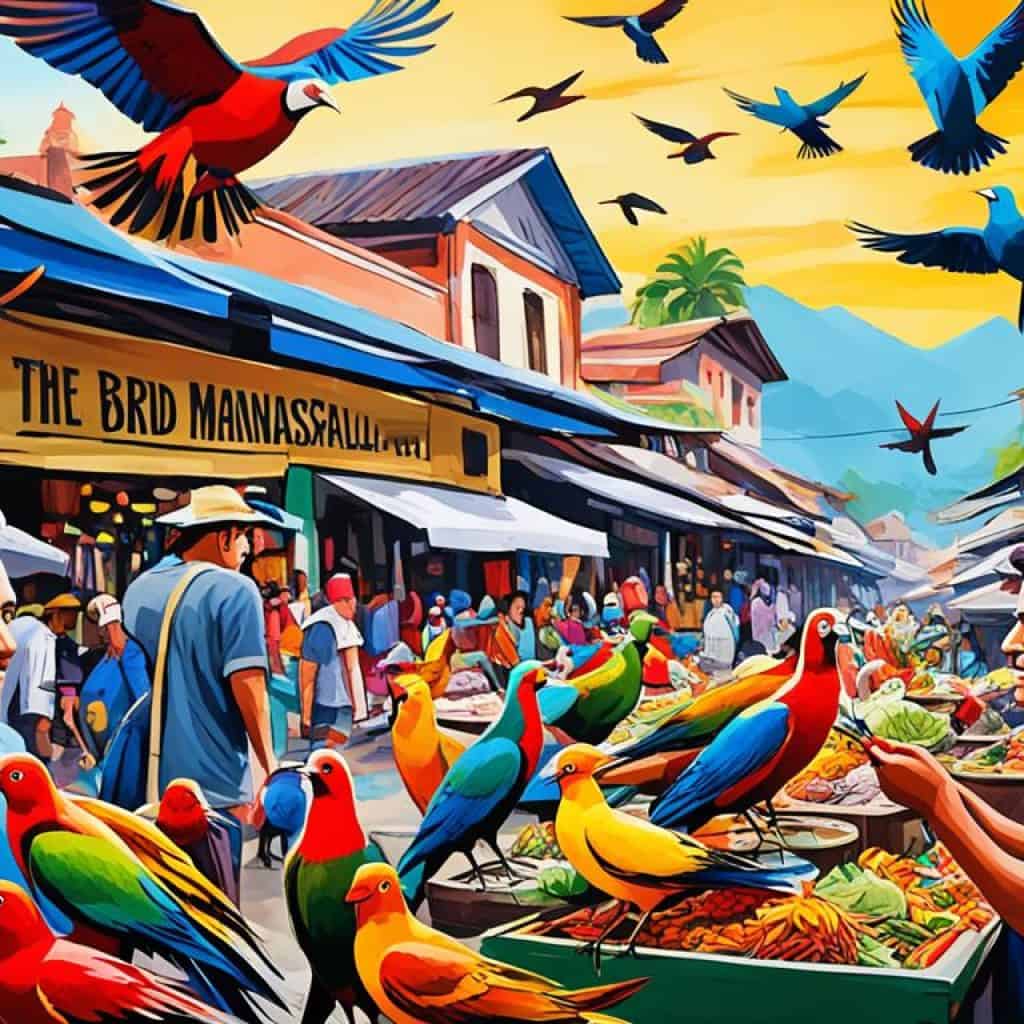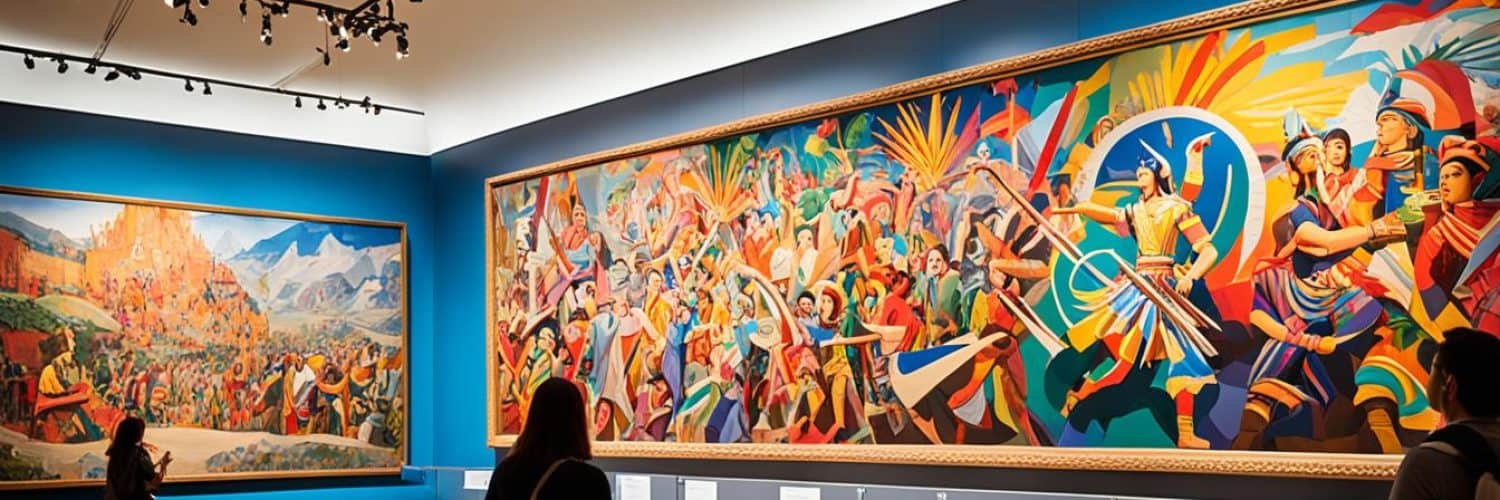Did you know that the Philippines is home to a wealth of famous artwork that embodies its history, culture, and artistic legacy? From renowned masterpieces to the works of Filipino art big names, these iconic art pieces hold a special place in the country’s artistic heritage. Join us as we delve into the world of Filipino art and explore the significance of these treasured artworks.
Key Takeaways:
- The Philippines boasts a collection of famous artwork that reflects its history, culture, and artistic legacy.
- Iconic Filipino art pieces showcase the talent and skill of Filipino artists.
- Exploring these masterpieces allows us to uncover the history and identity of the Filipino people.
- Filipino art has made a significant impact on the global art community.
- These treasured artworks represent the diverse and creative spirit of the Philippines.
Exploring the National Museum of Fine Arts
The National Museum of Fine Arts in Manila is a must-visit destination for art enthusiasts and history buffs alike. Located in a grand neoclassical building, this prestigious institution is home to a remarkable collection of famous artworks that embody the rich cultural heritage of the Philippines.
As you step into the museum, you’ll be transported on a captivating journey through time. The tour begins with the iconic painting “Spoliarium” by Juan Luna, a masterpiece that captures the raw emotions and historical significance of the Filipino people. This renowned artwork sets the stage for an exploration of the country’s artistic legacy.
The museum’s collection also includes a wide range of religious art from the Spanish colonial period. These exquisite pieces, created by talented artists whose names may be lost to history, reflect the deep religiosity of the Filipino people during that era. From delicate sculptures to intricately painted religious scenes, these artworks provide a glimpse into the profound faith that shaped the nation.
Continuing the journey, you’ll encounter the indelible mark of World War II on Philippine art. The museum showcases works that depict the grim realities of war, as well as the resilience and hope of the Filipino people. These poignant pieces serve as powerful reminders of the sacrifices made and the strength found amidst challenging times.
The National Museum of Fine Arts also embraces the modernist movement in Philippine art. Explore galleries dedicated to renowned Filipino artists who pushed artistic boundaries and brought new perspectives to the forefront. Marvel at their innovative techniques, vibrant colors, and thought-provoking subject matters.
With its diverse collection and immersive exhibitions, the National Museum of Fine Arts offers a profound appreciation for Filipino art and its big names. It is a testament to the artistic talent, heritage, and national pride of the Philippines.
Highlights of the National Museum of Fine Arts:
| Artwork | Artist | Description |
|---|---|---|
| “Spoliarium” | Juan Luna | A monumental painting that symbolizes the resilience and artistic prowess of the Filipino people during a time of colonial rule. |
| Religious art | Unknown artists | Exquisite sculptures and paintings that depict the deep religious devotion and cultural identity of the Philippines during the Spanish colonial period. |
| World War II art | Various artists | Powerful artworks that portray the impact of war on the Filipino people, showcasing their strength and hope in the face of adversity. |
| Modernist art | Carlos “Botong” Francisco and other Filipino modernists | Explorations of new artistic styles and themes that revolutionized Philippine art and embraced global artistic influences. |
Visiting the National Museum of Fine Arts is an enriching experience that will immerse you in the vibrant artistic legacy of the Philippines. Prepare to be captivated by the beauty, history, and creativity that unfold within its walls.
Juan Luna and the Iconic “Spoliarium”
Juan Luna’s Spoliarium is undoubtedly one of the most renowned and iconic artworks in the Philippines. This massive painting portrays the aftermath of a gladiator match in the Roman Colosseum, with lifeless bodies being carried away and armor being auctioned off. Luna’s masterful use of dramatic lighting and emotive expressions infuses the scene with a sense of urgency and vitality.
What truly sets Spoliarium apart is the fact that it was created by a Filipino artist during a time when the Philippines was under colonial rule. It serves as a testament to the exceptional talent and skill of the Filipino people, showcasing their ability to surpass their colonial masters in the world of art.
“Spoliarium symbolizes the triumph of Filipino artistry, defying the limitations imposed by colonialism.”
This monumental artwork captures not only the skill and creativity of Juan Luna but also represents the resilience and artistic spirit of the Filipino nation. It has become a symbol of national pride and identity, making it a true treasure of the Philippines.
| Artwork | Artist | Year |
|---|---|---|
| Spoliarium | Juan Luna | 1884 |
Religious Art of the Spanish Colonial Period
During the Spanish colonial period, religious art played a significant role in the Philippines. Paintings were primarily created to adorn churches and promote Catholic teachings. The National Museum of Fine Arts houses a collection of works by unknown artists from the 17th to the 19th centuries that showcase the religious art of this period. While some of these works may appear soulless and homogeneous at first glance, a closer look reveals the deep religious devotion and the subtle nuances of Filipino identity that were expressed through these paintings.
| Highlights of Spanish Colonial Art in the Philippines | Description |
|---|---|
| Santo Entierro de Antipolo | This artwork depicts the burial of Christ and showcases the intricate details and vibrant colors commonly found in Spanish colonial religious art. |
| El Ecce Homo | This painting represents the moment when Pontius Pilate presents Jesus to the crowd, highlighting the suffering and humility of Christ. |
| La Purissima Concepcion | Depicting the Immaculate Conception of the Blessed Virgin Mary, this artwork reflects the deep veneration of Mary in Filipino Catholicism. |
In addition to paintings, Spanish colonial art in the Philippines also included sculptures, altarpieces, and religious artifacts. These artistic expressions served as a visual means of conveying religious teachings and invoking spiritual contemplation among the Filipino faithful. The craftsmanship and attention to detail in these artworks reflect the profound devotion and fervent faith of the Catholic Filipinos during the Spanish colonial period.
“Spanish colonial religious art in the Philippines is a testament to the enduring influence of faith and the creative spirit of the Filipino people. Despite the often oppressive circumstances of colonial rule, these artworks highlight the resilience and ingenuity of the Filipinos in expressing their religious beliefs and cultural identity.”
The religious art of the Spanish colonial period continues to be an integral part of Filipino cultural heritage. It provides a glimpse into the history, spirituality, and artistic traditions of the Philippines, leaving a lasting impact on both the local and international art scene.

Luna and Hidalgo: Rivalry and Flaws
Juan Luna and Felix Resurreccion Hidalgo were two esteemed Filipino painters who emerged during the late 19th century. The National Museum of Fine Arts proudly showcases their works in the captivating gallery, “Los Dos Pintores Juan Luna Y Felix Hidalgo.”
Luna’s paintings embody his relentless pursuit of perfect academic discipline, showcasing his technical mastery and attention to detail. His works capture the essence of realism, depicting vibrant scenes that evoke a sense of awe and admiration.
“Portrait of A Lady” by Juan Luna
On the other hand, Hidalgo’s art is characterized by refined skill and technique, yet it has been criticized for its perceived lack of emotional depth. Although his paintings may seem restrained, they reflect the sophistication and sophistication of his artistic style, leaving viewers in awe of his technical prowess.
One particular painting that captivates art enthusiasts is Luna’s enigmatic masterpiece, “Portrait of A Lady.” Believed to portray his wife, it is shrouded in intrigue, as Luna was notorious for his turbulent personal life. Speculation surrounds the painting, as Luna allegedly mistreated and ultimately killed his wife in a fit of rage.
The Flaws in Luna and Hidalgo’s Artistic Styles
Despite their undeniable skills and contributions to Filipino art, both Luna and Hidalgo had their fair share of flaws. Luna’s tumultuous personal life often overshadowed his artistic achievements, tarnishing his legacy and creating a controversial narrative around his works.
Similarly, Hidalgo’s art has been criticized for lacking the emotional depth often associated with masterpieces. While his paintings showcase impeccable technique, some argue that they fall short in conveying genuine sentiments, leaving viewers with a sense of detachment.
However, it is important to acknowledge that these criticisms do not diminish the significant impact Luna and Hidalgo had on Filipino art. Their works serve as a testament to their extraordinary talent and enduring influence on the artistic landscape of the Philippines.
World War II and the Grim Art of Amorsolo
World War II had a profound impact on the art of the Philippines. Fernando Amorsolo, known for his mastery of light, depicted the dark and brutal events of the war in his paintings. His works showcased the destruction of buildings and the suffering of the Filipino people, yet maintained a sense of serenity and beauty.
Amorsolo’s art also went beyond the war and highlighted the everyday life of Filipinos, capturing the spirit and resilience of the people in the midst of adversity.
One of Amorsolo’s notable artworks during World War II is “The Burning of Manila,” which portrays the catastrophic destruction of the city during the Battle of Manila. Through his skillful use of light and color, Amorsolo evokes a sense of chaos and loss, while still preserving the beauty and strength of the Filipino spirit.
Another powerful piece by Amorsolo is “Suffering,” which depicts a group of Filipino prisoners of war. The painting encapsulates the misery and anguish experienced by the victims of war, yet the subjects’ stoic expressions and unified presence convey a sense of dignity and resilience.
“Amorsolo’s paintings from the World War II era are a testament to his talent and ability to capture the beauty and tragedy of the human condition,” says art critic Maria Santos. “His art serves as a visual reminder of the hardships endured during the war and the unwavering spirit of the Filipino people.”
Amorsolo’s contributions to World War II art in the Philippines have cemented his legacy as one of the country’s most renowned artists. Through his paintings, he sheds light on the grim realities of war while acknowledging the strength and resilience of the Filipino people.
| Artwork | Description |
|---|---|
| “The Burning of Manila” | Depicts the catastrophic destruction of Manila during World War II. |
| “Suffering” | Portrays the misery and resilience of Filipino prisoners of war. |
| “Rice Planting in a Ferocious Storm” | Showcases the perseverance of Filipino farmers amidst harsh conditions during the war. |
The Shift to Modernism
The post-war period in Filipino art ushered in a transformative shift as Western modernism began to influence local artists. This artistic movement, known as modernism, brought new perspectives, techniques, and styles to the Philippine art scene.
Modernism in Filipino art marked an era of experimentation and exploration, as artists sought to break free from traditional norms and embrace the avant-garde.
In the National Museum of Fine Arts, a gallery titled “Pillars of Philippine Modernism” showcases the works of modern artists who received training abroad. This collection is a testament to the integration of local and global artistic influences, solidifying the Philippines’ place in the international art scene.
One prominent figure in this movement is Carlos “Botong” Francisco. His vibrant paintings depict Philippine folk narratives, utilizing vivid colors and psychedelic imagery. Francisco’s works exemplify the fusion of traditional Filipino art with modern artistic influences.

This gallery exhibition reflects the dynamic nature of Filipino art, embracing new perspectives while honoring the rich cultural heritage of the country. The shift to modernism opened doors for artistic expression and experimentation, creating a diverse and vibrant art scene in the Philippines.
The Famous Paintings of Filipino Artists
Filipino artists have made significant contributions to the world of art, creating numerous famous paintings that have gained recognition both locally and internationally. These masterpieces have become cultural treasures and symbols of national pride, reflecting the diverse talent and creativity of Filipino artists. Let’s explore some of the most renowned works by Filipino artists and appreciate their significance in the art world.
Felix Resurreccion Hidalgo’s “La Laguna Estigia”
One of the noteworthy paintings by a Filipino artist is Felix Resurreccion Hidalgo’s “La Laguna Estigia.” This masterpiece draws inspiration from Dante Alighieri’s epic poem, “Inferno,” and depicts the River Styx, one of the circles of Hell in Dante’s narrative. With its Greco-Roman influences, vibrant colors, and meticulous details, “La Laguna Estigia” showcases Hidalgo’s artistic prowess and mastery of romanticism in Filipino art.
Vicente Manansala’s “The Bird Seller”
“The Bird Seller” by Vicente Manansala is another significant painting that exemplifies the Philippine modernist movement. Through his use of transparent cubism, layered shapes, and vibrant colors, Manansala captures the essence of native Filipino culture and identity. This artwork provides a unique perspective on ordinary life, demonstrating Manansala’s artistic innovation and influence in the modernist art scene.
Hernando Ocampo’s “Genesis”
Hernando Ocampo’s “Genesis” is a monumental painting that showcases the artist’s bold use of colors and abstract features. Originally created as a curtain for the Cultural Center of the Philippines, this artwork is visually captivating, with its vibrant hues and dynamic composition. Ocampo’s “Genesis” reflects his profound understanding of life and abstract elements, leaving viewers awestruck by his artistic vision.
These famous paintings by Filipino artists represent the artistic talent, cultural heritage, and identity of the Philippines. Each artwork tells a unique story and captures the rich diversity of the Filipino people. As cultural treasures, these masterpieces continue to inspire and evoke emotions, leaving a lasting impact on the global art community.
La Laguna Estigia by Felix Resurreccion Hidalgo
Felix Resurreccion Hidalgo’s “La Laguna Estigia” is a masterpiece that draws inspiration from Dante Alighieri’s epic poem, “Inferno.” This Greco-Roman painting depicts the River Styx, which represents one of the circles of Hell in Dante’s poem. The painting portrays a darker and more mysterious interpretation of the infernal realm, showcasing Hidalgo’s artistic prowess.
With meticulous attention to detail and a keen sense of atmospheric perspective, Hidalgo captures the ominous and haunting atmosphere of the River Styx. The dark, swirling waters convey a sense of foreboding and evoke a range of emotions in the viewer. The meticulous brushwork and careful use of light and shadow enhance the dramatic tension, creating a captivating visual experience.
Hidalgo’s Romanticism-infused style is evident in “La Laguna Estigia.” The painting’s evocative imagery, rich symbolism, and skillful execution embody the Romantic ideals of passion, emotion, and sublime beauty. Through this powerful piece, Hidalgo invites the viewer into a realm of dark enchantment, where mythology and art converge.
Inspiration from Dante’s Inferno
The subject matter of “La Laguna Estigia” finds its roots in Dante Alighieri’s infernal world. The River Styx, depicted in Hidalgo’s painting, symbolizes the boundary between the living and the dead. It is a place of torment and punishment, where souls are condemned for eternity.
“La Laguna Estigia” captures the essence of Dante’s vivid imagery and evokes the bleakness and despair that permeate the depths of Hell. Hidalgo’s masterful portrayal of this metaphysical realm serves as a testament to his ability to translate literary concepts into visual art.
Award-Winning Recognition
Upon its unveiling, “La Laguna Estigia” received critical acclaim and achieved international recognition. The painting was awarded a silver medal during the General Exhibition of the Philippines in Madrid in 1887. This recognition further solidifies Hidalgo’s position as one of the great Filipino masters of art.
Today, “La Laguna Estigia” continues to captivate art enthusiasts and collectors with its profound symbolism and exquisite execution. It stands as a testament to the timeless beauty and enduring power of Hidalgo’s artistic vision.
The Bird Seller by Vicente Manansala
Vicente Manansala’s “The Bird Seller” is a masterpiece that exemplifies the essence of the Philippine Modernist Movement. This Cubist painting skillfully captures the vibrant culture and everyday life of a Filipino man engaged in the act of selling birds.
Through the innovative use of transparent cubism, Manansala creates a visual spectacle that portrays depth and movement. The painting’s layered shapes and colors intricately depict the interaction between the bird seller and the surrounding environment, evoking a sense of energy and liveliness.
Manansala’s unique artistic style, influenced by Western modernism, merges seamlessly with indigenous Philippine art forms and motifs. The fusion of these elements brings forth a work that not only showcases the artist’s extraordinary talent but also reflects the rich cultural heritage of the Philippines.

“The Bird Seller” encapsulates the spirit of Philippine modernism, where artists embraced innovation and experimentation while maintaining a deep connection to their cultural roots. This painting is a visual testament to the dynamism and creativity of Filipino artists, cementing their place in the global art scene.”
Artistic Elements in “The Bird Seller”
| Artistic Element | Description |
|---|---|
| Transparent Cubism | Layered shapes and colors that create a sense of depth and movement |
| Indigenous Motifs | Incorporation of Philippine cultural symbols and references |
| Vibrant Colors | Expressive use of vivid hues to evoke energy and liveliness |
| Cultural Fusion | Integration of Western modernism with indigenous art forms |
“The Bird Seller” stands as a remarkable contribution to the Philippine Modernist Movement, showcasing Manansala’s artistic prowess and his ability to capture the essence of the Filipino identity. This masterpiece serves as a testament to the enduring cultural heritage of the Philippines and the country’s artistic journey.
Genesis by Hernando Ocampo
Hernando Ocampo’s “Genesis” is a monumental artwork that showcases his mastery of bold colors and abstract features. Created for the Cultural Center of the Philippines, this painting was woven onto a curtain that adorns the theater’s stage. The vibrant colors and dynamic composition of “Genesis” create a visually captivating experience. Ocampo’s art reflects his deep understanding of life and the abstract elements of the world, leaving viewers in awe of his artistic vision.
Ocampo’s “Genesis” is a testament to his innovative approach to Philippine modernist art. The painting combines vivid hues, geometric forms, and gestural brushwork to convey a sense of energy and movement. This abstract representation of the creation of life serves as a powerful visual metaphor, inviting viewers to contemplate the origins and mysteries of existence.
The Vibrant Palette of “Genesis”
One of the striking features of “Genesis” is Ocampo’s bold and vibrant color palette. The intense shades of red, yellow, blue, and green create a harmonious interplay, evoking emotions and stimulating the senses. The use of contrasting colors adds depth and dimension to the composition, enhancing the overall visual impact of the artwork.
Abstract Features and Symbolism
The abstract features in “Genesis” contribute to its thought-provoking nature. Ocampo’s expressive brushwork and fluid lines suggest movement and transformation, reflecting the dynamic nature of life and creation. The painting’s non-representational style allows for multiple interpretations and encourages viewers to engage with their own personal experiences and perspectives.
“Genesis” invites us to contemplate the mysteries of life, the universe, and the interconnectedness of all things. Ocampo’s abstract representation encourages viewers to question and explore their own beliefs and understanding of existence.” – Art Critic
Through “Genesis,” Hernando Ocampo has made a lasting contribution to Philippine modernist art. His bold use of color, abstract features, and symbolic imagery creates an immersive experience that transcends traditional boundaries. As viewers stand before “Genesis,” they are confronted with the power of abstract expression, compelling them to delve into the depths of their own imagination and contemplate the wonders of creation.
Las Virgenes Cristianas Expuestas al Populacho by Felix Resurreccion Hidalgo
Felix Resurreccion Hidalgo’s “Las Virgenes Cristianas Expuestas al Populacho” is a renowned painting that portrays the persecution of Christians in Ancient Rome. The artwork vividly captures the plight of female slaves who are subjected to mockery and ridicule by Roman men. Las Virgenes Cristianas Expuestas al Populacho is widely regarded as a masterpiece due to its exceptional quality, dynamic composition, and its representation of historical events.
“Las Virgenes Cristianas Expuestas al Populacho is not only a powerful depiction of the suffering endured by Christian women during this period, but it also serves as a powerful commentary on the plight of marginalized individuals in society. Hidalgo’s attention to detail and his ability to evoke emotion through his brushstrokes make this painting a truly remarkable work of art.”
Regrettably, the original painting was destroyed in a fire. However, a meticulous copy of this significant piece is displayed at the Central Bank of the Philippines, where it continues to serve as a testament to the nation’s cultural heritage.
Felix Resurreccion Hidalgo: Philippine National Treasure
Felix Resurreccion Hidalgo, a prominent Filipino painter, is widely recognized as one of the most influential figures in Philippine art history. His works, including “Las Virgenes Cristianas Expuestas al Populacho,” have garnered international acclaim and contributed significantly to the development of Filipino art.
| Key Information | Details |
|---|---|
| Full Name | Felix Resurreccion Hidalgo |
| Birthdate | February 21, 1855 |
| Place of Birth | Binondo, Manila, Philippines |
| Artistic Style | Realism, Academicism |
| Legacy | Considered a Philippine national treasure; his works have been designated as part of the Philippine National Treasures |
Conclusion
The famous artworks in the Philippines, from Juan Luna’s “Spoliarium” to Vicente Manansala’s “Madonna of the Slums,” are true masterpieces that showcase the rich artistic legacy and cultural heritage of the country. These iconic pieces not only tell captivating stories but also evoke powerful emotions, contributing greatly to the vibrant art scene in the Philippines. Exploring these treasured artworks enables us to delve deeper into the history, identity, and creative spirit of the Filipino people.
Each artwork reflects the unique experiences and perspectives of its creator, capturing the essence of Filipino culture and society. They bring to life significant moments in history, depict the struggles and triumphs of the Filipino people, and convey the beauty of the Philippine landscapes. These masterpieces have made a lasting impact on the global art community, captivating audiences worldwide with their exceptional craftsmanship and profound artistic expression.
The art of the Philippines continues to thrive, with talented Filipino artists creating new masterpieces that push creative boundaries and challenge societal norms. Through their works, they celebrate the country’s diversity, promote social awareness, and inspire positive change. The famous artworks in the Philippines stand as a testament to the country’s artistic excellence and serve as cultural treasures that uphold national pride.
As we continue to appreciate and honor these masterpieces, we strengthen our connection with the artistic legacy of the Philippines. By immersing ourselves in the world of Filipino art, we gain a deeper understanding of the stories, traditions, and aspirations of the Filipino people. The famous artworks in the Philippines will forever be cherished as a significant part of the country’s heritage and an enduring source of inspiration for generations to come.


















Add comment